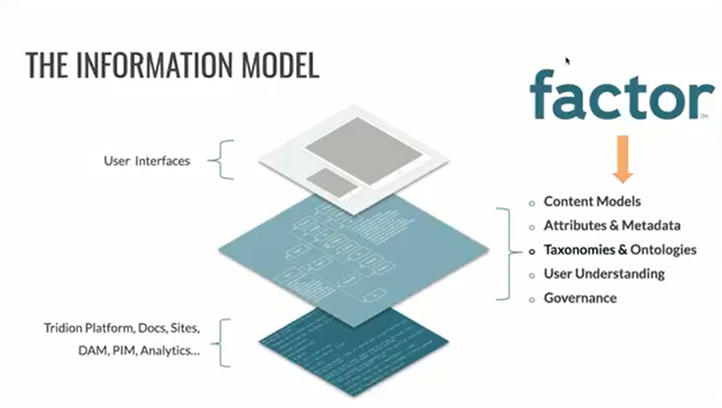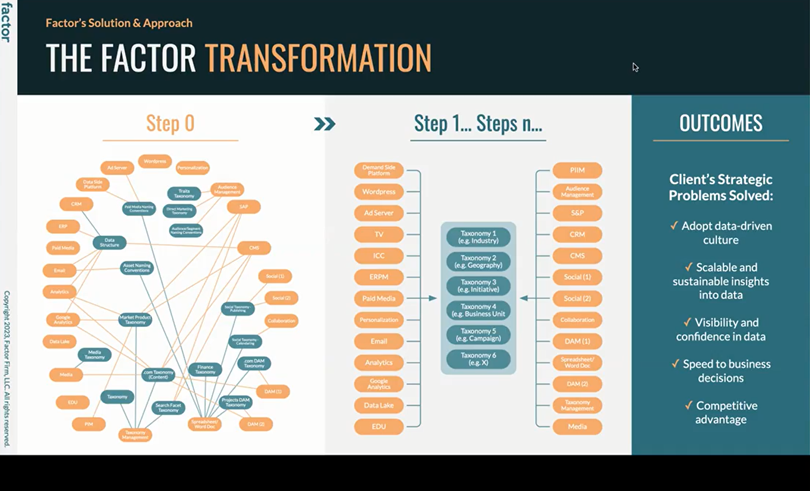Enterprise-wide information model for maximum value & insights to users

Recently, Tridion convened with its partner Factor to discuss the joint value proposition of working with mostly Fortune 500 companies. Elsa Sklavounou, RWS’ VP of AI Alliances, Global Partnership, organized the event.
From the Factor team, we had Gary Carlson (Principal and Founding Partner) and his core team walk us through details about Factor and how Factor and Tridion bring complementary and powerful value to our large enterprise customers.
Introduction: All-encompassing information architecture and taxonomy consulting
Gary introduced Factor as an information architecture and taxonomy boutique consultancy with a strong focus on User Experience (UX) at the enterprise scale. Factor strives to solve the most complex information challenges in enterprise environments.
Gary provided extensive lists of clients that Factor collaborates with, encompassing a range of renowned companies. Additionally, Gary emphasized Factor's holistic approach to information architecture, stressing the importance of aligning information structures with the strategic objectives, governance requirements, interconnected technology platforms, as well as the various stakeholders and operational aspects within enterprises.
Factor’s Information Model connects UX to Tridion
Factor builds an information model/or layer that accounts for all the artifacts, such as attributes & metadata, taxonomies and ontologies, user understanding, and governance that describe the organization’s content.
Gary drew comparisons and similarities between their information modeling with that of Tridion’s other partner Pool Party, the key difference being that Factor implements it at an enterprise-wide level and not just at the system level.

All these artifacts must be implementable across all different systems, such as Tridion, analytics, DAM, etc. This model is built to work seamlessly across all these systems so they can communicate. On the other end, there are user interfaces where all the information gathered from these systems will be consistently delivered.
Client Case Study
On request from Tridion’s team, Gary shared a case study below in which the orange boxes represent the client’s systems and the green boxes represent the metadata or taxonomies. The client was unable to drive enterprise analytics. The client spent as much as $2B annually but could not measure their marketing campaigns’ effectiveness.
The reason became clear once Factor plotted this diagram on the left, showing the several silos in which these systems were functioning. This didn’t allow Factor’s client to generate a ‘single enterprise-wide analytics view. Each department used different taxonomies/metadata, and the marketing campaign's basic definition too varied across different teams.

With insights from the client’s VP of Marketing, Factor built this lean and effective information model on the right of the picture above. Core taxonomies that define their business, such as industry, geography, initiative, business unit, etc. (total 16-17), were used to build the information model.
Also, Factor ensured that these taxonomies were flexible enough to cater to each system’s varied needs, whether technical capabilities or local use cases. With this information model, they can run fundamental analytics across the enterprise and support sales enablement, content management, end-user experience work, and partner platform.
The Tridion team agreed with the need for such an information model based on their experience with the clients. Tridion agreed that there needs to be a common and consistent set of taxonomies across the enterprise. As Tridion serves as the central repository of information, it needs to account for needs across all the departments. It hence should be equipped with all the taxonomies to serve different departments.
Factor and Tridion joint use case scenarios
Gary listed three scenarios in which Factor can work with Tridion to help enterprises derive maximum value from Tridion’s system:
- An enterprise wants to implement Tridion but does not have the information architecture (taxonomies and metadata) ready to plug into Tridion
- An enterprise wants to implement Tridion into a complex environment that requires heavy ‘reuse’ of taxonomies & metadata due to multiple integrations and touchpoints
- An existing Tridion client that is not able to derive maximum value from Tridion due to improper or poorly implemented information architecture
Factor works tirelessly to accelerate time to value in all such scenarios.
Answering one of the Tridion team members, Gary mentioned that such a consistent information model is ‘relatively’ easier to build in heavily regulated industries as there is a strong need for compliance across all the departments of the enterprise. It is more challenging in other industries as one needs buy-in from several stakeholders across different departments.
Tridion has a significant presence in heavily regulated industries such as insurance and pharmaceutical; hence, its customers can optimally benefit from Factor’s information model. Gary clarified that Factor’s information model solution is industry agnostic and they have worked across several industries serving multiple use cases.
Information model implementation and timeline
Gary outlined two steps that are involved in building the information model:
- A workshop to understand the client's information environment's current and desired future state. It involves identifying business drivers and the scope/nature of the information architecture challenges and opportunities. The deliverable is a strategic summary and high-level roadmap to help the client accelerate time to value. This is, on average, 2 to 3 weeks of engagement.
- The next stage involves developing and implementing the information model and the time involve depends on the number of systems involved, business goals, user experience needs, etc. And based on that, Factor has implemented such a model on the lower end in 6 months and at the higher end in 5 years.
Elsa raised a question about Factor’s ability to work with external taxonomies and Gary referred to the client case study presented. Gary mentioned that the case study client was using Synaptica Taxonomy and Ontology Management software for taxonomies. Factor worked with that and hence can, for example, work with Tridion’s partner PoolParty’s Wand solution.
Bram mentioned a healthcare client that Factor worked with. This client had taxonomies from external organizations such as SNOMED (which determines global health standards). These are standards-based taxonomies, Factor worked with these and then layered taxonomies on top of that based on the client’s specific needs.
Bram mentioned that in most of their projects, external taxonomies are involved. And they integrate taxonomies from various sources, both internal and external, into the information model that is shareable across the enterprise. It serves all the different use cases that participants across the enterprise have.
To tie Factor’s work with Tridion’s solution, Gary shared an approach chart depicting how a CCMS like Tridion fits into their information modeling work:

Gary mentioned that they begin from a higher-level client objective: customer experience, sales enablement, personalization, etc. Then they look at the various touchpoints involved (where the information will show up) and the systems involved (this is where a CMS system features).
Based on this, Factor starts to build out the various taxonomies need to support the various department user needs, whether it is customer, product, marketing, sales, etc. Factor can work with specific system needs (e.g., Tridion-specific) and at the enterprise-wide level dealing with several systems, as Gary discussed in the case study presented earlier.
To round it up, Bram mentioned that Factor has worked with several sales enablement CMSes in the past. The goal in such cases has been to build and structure the taxonomies so that the CMS information can serve various business needs.
Bram mentioned that in many instances where CMS also serves as a system of record that shares structured taxonomies with other systems. And, of course, these taxonomies need to be modeled around business needs and that’s where Factor becomes relevant and specializes in.
If you would like to learn more about how Tridion can help your business, click here.

